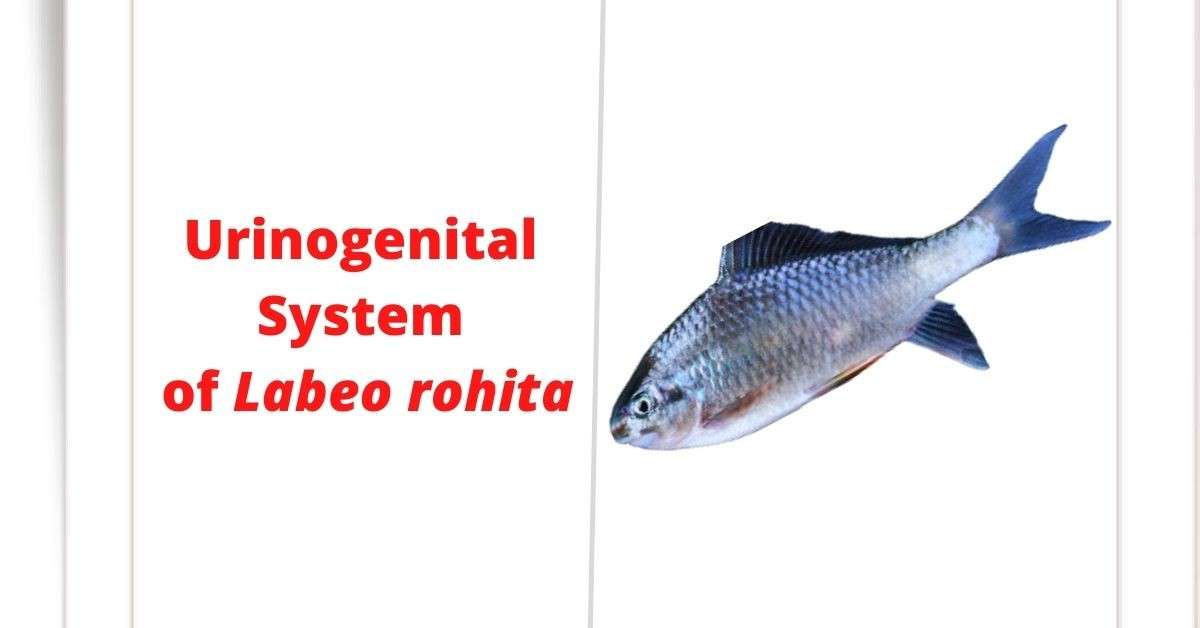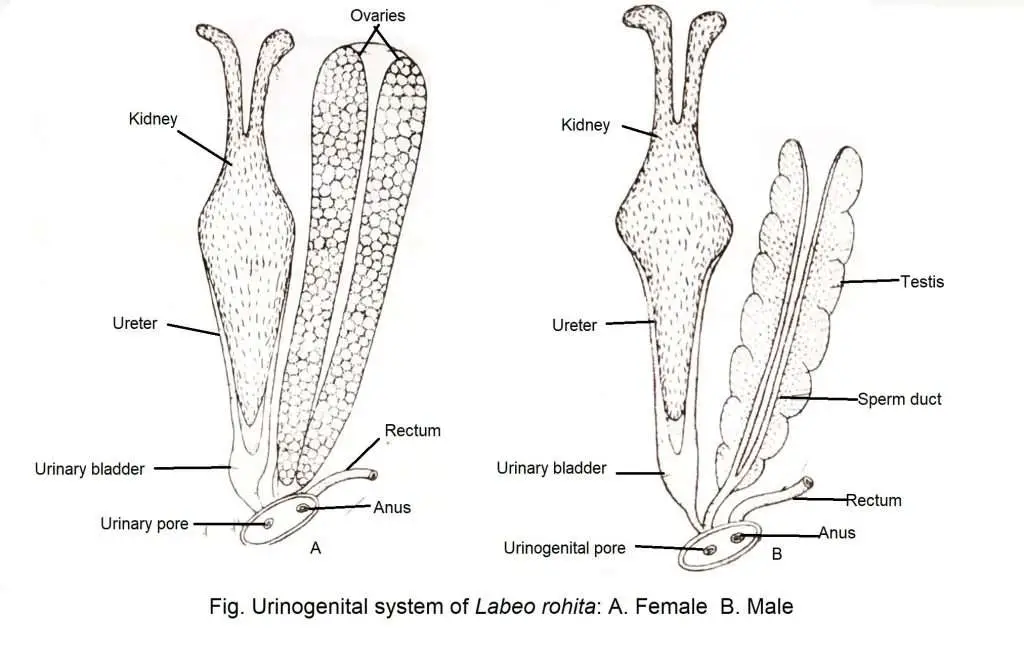Kidney is the main excretory organ of Labeo rohita (Rohu fish). Some differences are observed in the excretory organ and excretion process of Rohu fish due to their living in aquatic environment. This is because even though the main excretory organ or the kidneys of rohu fish take part in the excretory function, the gills as a respiratory organ also play a supportive role in the elimination of excretory products. There are two long reddish brown colored kidneys in body cavity of Labeo rohita, placed on the ventral side of the vertebral column.
The kidneys of Rohu are of the Masonephric type. Due to the close relationship between the kidneys and the genital organs, excretory system and reproductive system are discussed together as urino-genital system. The two ends of the kidneys are free, but the middle ends are connected to each other. The tip of each kidney is narrow and contains lymphoid tissue. This part does not participate in excretion. Each kidney contains many uriniferous or renal tubules.
At the apex of each tubule, two-layered funnel-like Bowman`s capsule is situated. The capillaries of the Bowman`s capsule contain blood capillaries in the form of coils. This is called glomeruli. The Bowman`s capsule and the glomerulus together form the Malpighian body. Here, the excretory products from the blood is separated. The uriniferous ducts meet on one side of the kidney to form a mesonephric duct or wolfian duct.
The mesonephric duct protrudes posteriorly into the ureters. The two ureters subsequently join together to form a swollen sac-shaped urinary bladder. The bladder is opened into the posterior urino-genital sinuses. In the case of male fish, the bladder is lined with spermatozoa and released outside the body through the urino-genital pores. The bladder of the female fish is exposed outside the body through the urino-genital sinuses through separate excretory pores. The excretory pore of male and female fish is located below the anal pore.
Process of Excretion
Labeo rohita produces urea and ammonia as excretory substances through excretion. Blood-carrying excretory substances are filtered into the glomeruli after entering the Bowman`s capsule through the renal arteries. The filtered liquid contains urea, glucose, various types of salt and water. The required portion of the filtered fluid is absorbed into the inner wall of the renal tubules and the remaining fluid, in the form of urine, enters the urinary bladder through ureters. From there, it is discharged out of the body through urino-genital pores.
Reproductive System
Although the Labeo rohita is a uni-sex animal, its sexual dimorphism cannot be easily determined. They reproduce through sexual reproduction and their fertilization is external. Their reproduction is largely dependent on the environment.
Male reproductive system
A pair of elongated testes are located in the abdominal cavity below the swimbladder in the male Rohu fish. Each testis is attached to the body wall by the folds of the peritoneum or mesorchium. During the breeding season, the testis are fully developed and turn pink. One testicle is formed from the posterior side of each testis.
The two testicles meet at the back to form a small genital duct. The genital duct later merges with the ureter to form a normal urino-genital duct. After entering the urino-genital sinuses, this duct is released outside the body through the urino-genital pores. Sperm or milt is produced from the testis during the breeding season.
Female Reproductive System
A pair of oblong ovaries are located on the ventral side of the kidney in the body of female fish. The ovaries are attached to the body wall by two membranes called the mesovarium. The two ovaries become enlarged during the breeding seasons and cover the entire abdominal cavity. They do not have any ovarian canal in their ovary. The ovum is produced from the mature ovary and is released directly into the body cavity. From there, the ovum exits the body through a pair of genital pores in the wall of the urino-genital sinus.
Reproduction
Like other carp species, Rohu fish cannot reproduce normally in confined water bodies. During the breeding season in flowing water bodies, they take part in natural reproduction. At first, sexually mature male and female fish exhibit ejaculation before breeding. At this time, they swim against the current and rub each other. As a result, they become sexually excited.
In the case of sexual arousal, the female fish first lays thousands of eggs in the flowing water. This process of laying eggs is called spawning. Eggs of Rohu fish are relatively small and become yolky. At this time, the male fish releases milt on the egg. As a result, the fertilization of sperm and ovum occurs. In this case, their fertilization process is external type.
The fertilized zygote produces hatchlings after passing through various embryonic stages through continuous mitosis cell division or cleavage. Their embryonic development is direct, meaning that no larval stages are formed in the life cycle. The hatching of eggs occur within 2-15 hours. Newly hatched fry is 2-3 mm long with prominent yolk sac which is located at the ventral side of the body. The yolk sac is disappeared within 5-7 days. At this time, the fry contains fringed lips with prominent vertical dark spot at the base of the caudal fin. In this condition, they start to take natural food and they turn into fingerlings within few days with 5-15 mm in length. Then, fingerlings become a few inches long. Thus, the mature stage of Rohu fish appears at the end of the embryonic development.
At present, Rohu fish are being commercially produced in various fish farms through the application of hormone injections in artificial or infused breeding methods. It should be noted here that the sexual maturity of rohu fish requires about two years.


